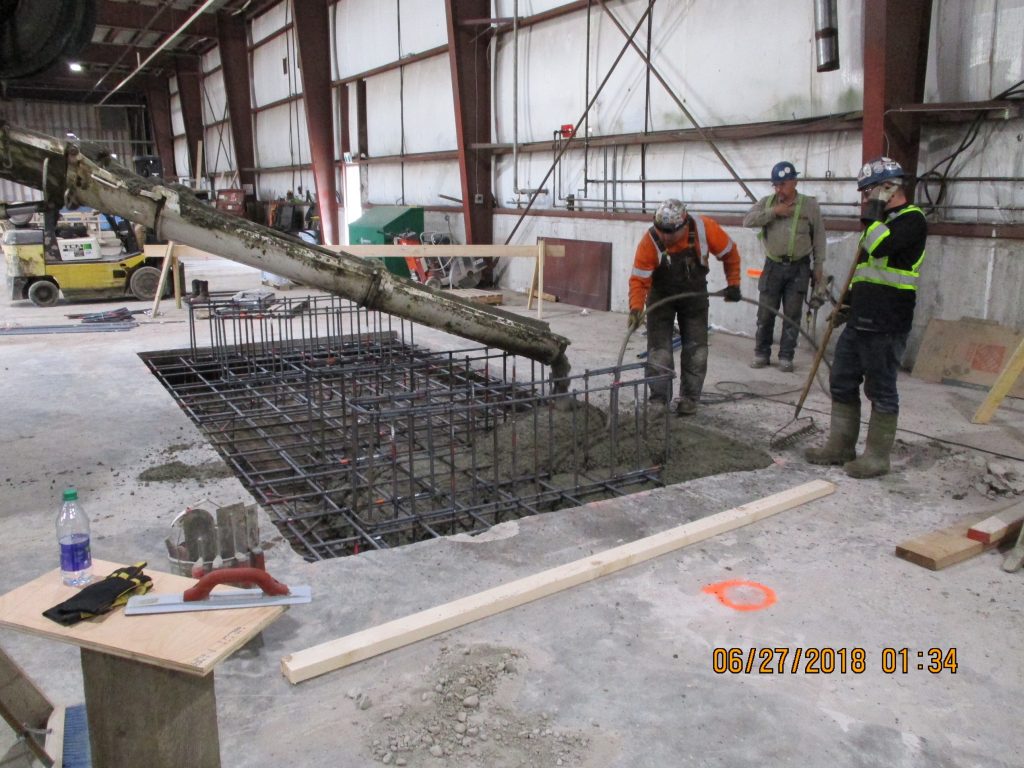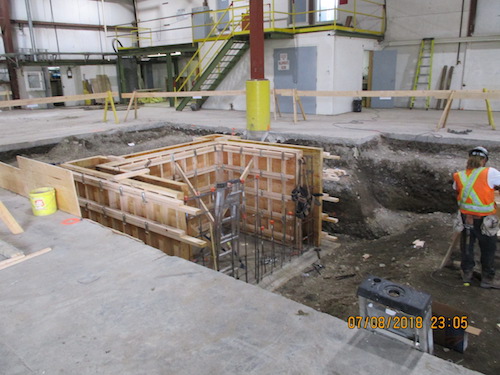
New pellet plant coming on the map
July 27, 2018
By
Tamar Atik
July 27, 2018 - A new pellet plant taking shape in Terrace, B.C., is expected to set a new standard in environmental compliance for the industry, if the company and supplier building it have it their way.
 Contract employees complete the first concrete pour of the cooler foundation at the Skeena BioEnergy site.
Contract employees complete the first concrete pour of the cooler foundation at the Skeena BioEnergy site.
“It will be Prodesa’s first complete system installation in B.C. and we would like this to be a showcase for both our company and for them. We’d like it to set a high benchmark for environmental compliance,” Skeena Sawmills’ vice-president Roger Keery tells Canadian Biomass.
Skeena BioEnergy is the name of the new $20-million pellet plant (and company) being built next to Skeena Sawmills. Construction started in June and is expected to be completed by December 2018, with commissioning in January 2019.
“It took us four years, and we looked at a wide range of alternatives,” Keery says. “We looked at some different technologies re-using sawmill residuals. We looked at bio-naphtha and bio-ethanol and we also looked at producing biogas in a closed electrical generating system.”
Skeena BioEnergy is being built in an existing building that used to house a veneer company. Skeena Sawmills owns the site and the building. It operates a large sawmilling operation in Terrace and its need for an adjacent pellet plant was clear.
“We needed to add value to our sawmill residuals — sawdust and hog fuel,” Keery says. “We’re currently not able to recover any value from our shavings or sawdust or hog fuel and our pellet business turns that into a revenue source for the company.”
The residuals are currently split into two flows. The bark component is land-filled and the whitewood component is sold to a pellet manufacturer which Keery says is approximately a 12-hour round-trip haul.
Skeena BioEnergy is being sized based on consuming all of the residual material from Skeena Sawmills, which will supply the feedstock to the pellet plant. The plant will produce pellets from all residuals including planer shavings, sawdust, hog fuel and bark.
Keery says there is a possibility for Skeena BioEnergy to receive feedstock from neighbouring sawmills or biomass harvesters, depending on the demonstrated capacity of the plant.
“The plant has designed an additional capacity that may be able to take material from other producers, but it will depend on the run-ability of the plant,” Keery says.
The need to operate Skeena BioEnergy under a different name was also a carefully thought-out decision, Keery explains. “We see the pellet business as a very different business from our sawmilling business,” he says. “It’s also possible we’ll have partners in the business at some point, so it allows us to do that without dealing with the partnership in the bigger context of our sawmilling and timber operations.”
Keery says there are a number of potential customers identified from the Asian market, but a final decision has not been made yet on who the customers will be.
“Our focus is Asia. It’s the focus of our lumber business, and naturally is the focus of our pellet business, so we’re looking in Asian countries — Japan, Korea, and potentially China, although that’s not possible at this point due to regulatory restrictions,” Keery explains.
Upon completion, Skeena BioEnergy will employ 12–15 people and is expected to produce 75,000 tonnes of pellets a year. There are currently six contract employees working on the construction site.
“We have an excellent crew of people working on the job,” Keery says. “Our primary civil and mechanical contractor is Salem Contracting, and we believe they’re one of the best companies in the industry at their work.”
Prodesa is Skeena BioEnergy’s chosen equipment supplier for the entire project.
“We looked at a variety of suppliers, and we chose Prodesa because of their experience in pelletizing, the quality of their equipment and their ability to supply a complete designed system,” Keery says. The goal for both Skeena and Prodesa is to be a showcase for environmental compliance in the industry.
Keery says Skeena BioEnergy’s plant emissions are going to be very tightly controlled, and safety is top of mind with investments in the fire detection systems, explosion prevention and a control system.
There are two technologies involved in the control of the plant’s emissions. Keery explains that the first is a wood drying technology which is a belt dryer system that is fired by natural gas. Keery says the emissions testing results of that technology been excellent, noting that a couple of other installations of this system are in place elsewhere.
The second technology, Keery explains, is the control of dust emissions from the various dust generating points in the plant. They’re all collected to one location and put through a filter unit, so the discharge will be filtered through an air filtration system, he says.
“Those are the only two airborne discharges from the plant and both are very well-controlled and will be standards that are orders of magnitude less than those normally associated with our sawmill operation,” Keery says.
The investments in the various systems within the plant are with different suppliers. Prodesa, as mentioned, is supplying the major equipment in the plant, each with its own fire and explosion protection system. This includes the dryer, hammer mill, pellet cooler and storage silos among other pieces.
| A glimpse of the cooler basement at Skeena BioEnergy where foundation work is being completed. |
| Photo//Supplied |
The VETS Group is supplying the dust filtration system, which also includes fire protection and explosion control.
And SonicAire is supplying a dust control system that will control dust in the air inside the plant.
Skeena BioEnergy will have one belt dryer, two infeed lines, three pelletizers and one cooling tower.
“We used the best available technology in designing the safety systems and the dust control in the plant,” Keery says. “And we’ve designed the plant to allow us to blend different types of input material, so the infeed system allows us to blend different products in a controlled way in our feedstock.
The process involves two separate feed systems that are individually controlled and allow a blending of materials on the infeed to the plant, Keery explains. “We have a dual infeed system that’s controllable to give the operator of the plant the ability to mix the two products in a controlled proportion,” he says.
Although Skeena BioEnergy is located adjacent to a rail line, all the products will ship out on trucks. Keery says the option of rail is available but requires trans-loading because it isn’t immediately accessible at the plant.
Keery says Skeena BioEnergy doesn’t have plans to put in a bagged pellet system currently, but is interested in considering the domestic market, possibly through local access to bulk pellets.
“The local market is appealing to us. While small, we think it’s an important part of being in the community, that the community can use our product,” he says. “So, we’re interested in considering how we might best do that. We haven’t decided that yet.”
“This is perhaps the most important project for our company,” Keery notes. “Our company has struggled with both addressing the issue of sawmill residuals and finding value in those residuals, so there’s a great deal of excitement around this project. It’s an enabling project for Skeena Sawmills to be successful.”
Skeena Sawmills and Skeena BioEnergy are owned by Roc Holdings, which was launched in 2012 by Chinese immigrant Teddy Cui. Skeena Sawmills was purchased from West Fraser Timber the same year and began operation under its new private ownership in 2013.
The Skeena BioEnergy project is also entirely privately funded through its ownership.
Print this page
